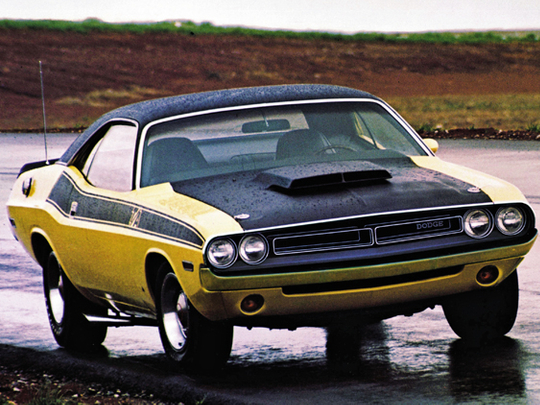
By the mid Sixties, Americans were getting fed up of only seeing racing cars go in a straight line at the drag strip or round and round on oval tracks. A little more variety was badly needed, so, when the Sports Car Club of America’s Trans Am road racing series was introduced in 1966, racing fans lapped it up.
No sooner had it begun, it found a place in American hearts. Carmakers knew it was a chance for them to showcase their products in front of millions of adoring fans, and as a result, legends such as the Chevrolet Camaro Z28, Ford Mustang Boss 302 and the Pontiac Firebird Trans Am were born.
Chrysler wanted in on the action, and so in 1970, it homologated the Dodge Challenger T/A — short for Trans Am — and 2,400 T/As were built to support one SCCA race car. It was a totally different animal to the Highline trim Challenger that it was based on, and certainly the most radical-looking of the breed offered during the car’s production run between 1970-1974.
For one, it came equipped with an exclusive spoiler at the rear, a fibreglass bonnet (which didn’t have hinges and could be lifted off completely) with a huge hood scoop moulded into it and flared fenders to house the fat E60 and G60 Polyglas rubbers — one of the first production cars to offer different sized tyres at the front and back.
The matte black paint, bonnet pins and thick stripes gave these models a unique look, while the 15in Rallye wheels with dog dish hubcaps and trim rings looked nothing short of superb. The camber of the rear wheels was increased (this raised the tail to give it a really menacing stance), and its suspension was beefed up with heavy-duty everything — from thicker torsion bars to stiffer leaf springs. It even got a fast-ratio steering box to make it more manoeuvrable.
You couldn’t mistake one of these for the base model, but if there were any lingering doubts, they were soon extinguished when you caught sight of the enormous, low-restriction dual exhausts; the chrome-tipped ‘megaphone’ outlets peeked out in front of the rear wheels rather than from the rear bumper and were the perfect finishing touch to what was an extremely tough-looking car.
But it didn’t just look tough, it had the go to match the show. Under the massive bonnet of the T/A, sat a 340-cubic-inch (5.6-litre) V8 with a six-pack carburettor atop an Edelbrock aluminium intake manifold. It was mated to either a three-speed automatic, but the majority had a four-speed manual with the Pistol Grip lever.
Output was immense; it made around 350bhp and could do the quarter mile in 14 seconds. However, the T/A struggled in both the SCCA and on the street. It was too heavy (1,655kg) and because it had so much torque (470Nm), it suffered a lot from understeer.
Regardless, the brawny 340ci V8 and the fabulous livery made it a winner in everyone’s eyes, the popularity of the vehicle helped, no doubt, by the 1971 hit movie Vanishing Point. Today, prices can rise up to the Dh350,000 mark for a well-kept, numbers-matching example. But that’s nothing for one of the most iconic cars of all time.











